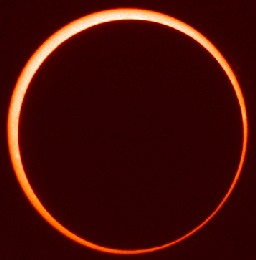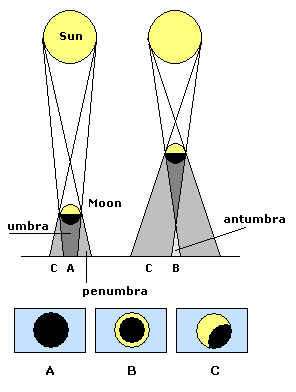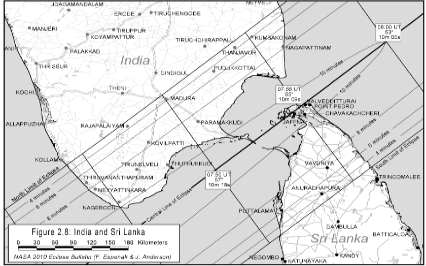Annular Solar Eclipse of 2010 January 15
The annular eclipse of the Sun is going to be visible across Africa, the Indian Ocean, Maldives, India, Sri Lanka, and south-east Asia. The apparent size of the Moon will not be big enough to cover the Sun's disc completely. That means there will be no 'totality' from anywhere on Earth. What you will see instead is a visible bright ring around the Moon if you position yourself properly. The annular phase begins at 05:13:54 UT in the Central African Republic and ends on the Chinese Yellow Sea coast at 08:59:01 UT. This annular is the longest of the third millennium (year 2001 – 3000). The Solar eclipse on January 15 is an annular eclipse and in Bangalore it will be partial with a magnitude of 84.6 percent. the partial eclipse will begin at 11:16 am and will achieve maximum percentage at 1:23 pm. The last point of the eclipse will be at 3:11 pm, making up a total time of four hours. A partial solar eclsipse, could be more dangerous than a total eclipse, so do not look at the sun directly, use a solar filter with optical density of 5.0 or more. This means that only 0.01% of the Sun's light can pass through the filter or certified eclipse goggles.
IIA, Bangalore campus will be open to public between 11.00 am to 3.00 pm for public viewing of partial eclipse
 |
 |
| Eclipse geometry: |
A Total eclipse in the umbra.
B Annular eclipse in the antumbra.
C Partial eclipse in the penumbra
Activities at Bangalore, Kanyakumari and Gauribidanur:
- Photometry of the sun at Max annularity at Kanyakumari
- Videography of the partial and annular phase at Kanyakumari
- Public viewing at IIA, Bangalore
- Radio interferometry experiment at Gauribidanur
Deatils on the radio experiment:The solar corona can be routinely imaged from the ground in the frequency range 30-300 MHz since the observed radiation originates primarily there. The main limitation in the observations is the angular resolution. For eg. one requires a radio antenna of size 75 km to probe the solar atmosphere for the existence of structures with angular dimension ~ 10 arc sec at 100 MHz. It is practically difficult to construct radio antennas of the above dimension and observe with them, particularly at low frequencies. And presently there are no antennas of this dimension in existence.
The size of the Gauribidanur radioheliograph with which we routinely image the solar corona is about 3 km and this gives a resolution of about 240 arc sec at 100 Mhz. A resolution of 10 arc sec corresponds to about 7000 km on the Sun. It is therefore natural to ask the question whether radio emitting structures of the above dimensions exist at the aforementioned height in the solar corona?. Obviously, we will not know the answer to this question until we make observations, but a number of considerations suggest that there will be radio wave emitting structures associated with coronal loops that can be usefully observed.
During a solar eclipse, angular dimensions of the radio wave emitting structures on the Sun located along the trajectory of the Moon can be investigated with extremely high angular resolution using the diffraction effects provided by the Moon's sharp limb. The limiting angular resolution is determined by the Earth-Moon distance and not by the size of the antenna system used for observations. Taking the Earth-Moon distance to be about 0.38 million km, we get an angular resolution of about 12 arc sec at 100 MHz and even a small portable antenna of size ~ few metres can be used to observe the solar corona with the above resolution (as compared to an antenna of size 75 km required to achieve this resolution on non-eclipse days as mentioned in the 1st paragraph). This is the main advantage of carrying out radio observations during a solar eclipse.
The science goals are:The limiting sizes of radio wave emitting source on the Sun. This will provide clues to the problem of whether the corona is a continuous medium or composed of small scale radially elongated fibrous structures. The filling factor issues can be better understood through observations of small sized sources.
The observed source sizes provide information to the understanding of turbulence in the electron density distribution close to the Sun which is very essential to model the solar corona. Note that solar wind observations provide reliable information about density turbulence at distances > 10 solar radii.

Annular Path - India

